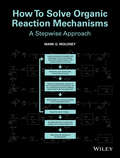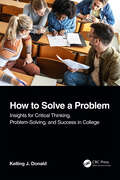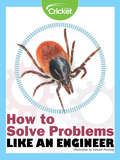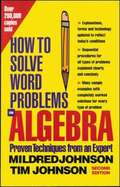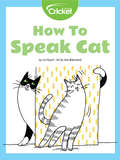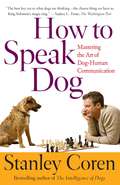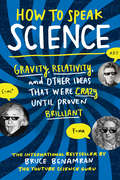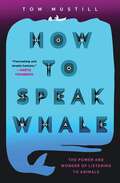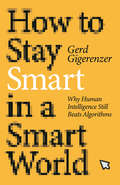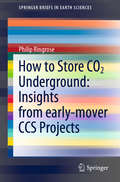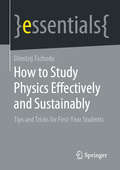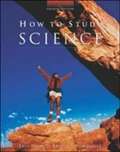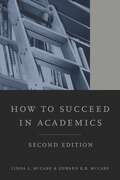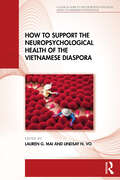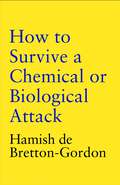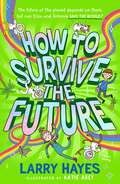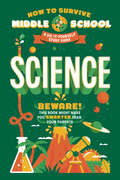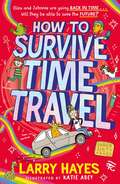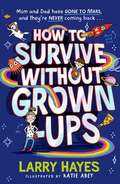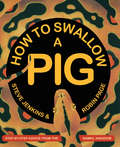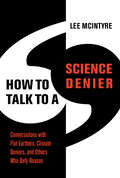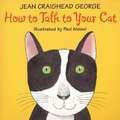- Table View
- List View
How To Solve Organic Reaction Mechanisms
by Mark G. MoloneyHow To Solve Organic Reaction Mechanisms: A Stepwise Approach is an upgraded and much-expanded sequel to the bestselling text Reaction Mechanisms at a Glance. This book takes a unique approach to show that a general problem-solving strategy is applicable to many of the common reactions of organic chemistry, demonstrating that logical and stepwise reasoning, in combination with a good understanding of the fundamentals, is a powerful tool to apply to the solution of problems.Sub-divided by functional group, the book uses a check-list approach to problem-solving using mechanistic organic chemistry as its basis. Each mechanistic problem is presented as a two-page spread; the left-hand page introduces the problem and provides a stepwise procedure for working through the reaction mechanisms, with helpful hints about the underlying chemistry. The right-hand page contains the full worked solution and summary.This revised edition includes the following updates:* A new chapter which applies the problem solving strategy to ligand coupling reactions using transition metals* Much-expanded set of fully worked problems* Over 40 further problems (with answers for tutors) for use in tutorialsHow To Solve Organic Reaction Mechanisms: A Stepwise Approach is an essential workbook for all students studying organic chemistry, and a useful aide for teachers of undergraduate organic chemistry to use in their tutorials.
How to Solve A Problem: Insights for Critical Thinking, Problem-Solving, and Success in College
by Kelling J. DonaldThis concise and accessible resource offers new college students, especially those in science degree programs, guidance on engaging successfully with the classroom experience and skillfully tackling technical or scientific questions. The author provides insights on identifying, from the outset, individual markers for what success in college will look like for students, how to think about the engagement with professors as a partnership, and how to function effectively in that partnership toward achieving their pre-defined goals or markers of success. It is an ideal companion for science degree prospects and first-generation students seeking insight into the college experience. Offers transferable problem-solving ideas and skills applicable for other disciplines and future careers. Provides new students with support and inspiration for their college experience. Includes guidance for successful interactions with professors, peers, professionals, and others. Encourages thoughtful determination of desired outcomes from the college experience and shaping one's actions toward accomplishing those objectives.
How to Solve Problems Like an Engineer
by Mary Beth CoxSome everyday problems can be solved using a series of steps called the Engineering Design Process.
How To Solve Word Problems In Algebra, 2nd edition
by Mildred Johnson Tim Johnson"There is no area in algebra which causes students as much difficulty as word problems. Most textbooks in algebra do not have adequate explanations and examples for the student who is having trouble with them...All major types of word problems usually found in algebra texts are here. Emphasis is on the mechanics of word-problem solving because it has been my experience that students having difficulty can learn basic procedures even if they are unable to reason out a problem." Author.
How to Speak Cat
by Liz HuyckDo you love cats? Do you ever wish you could talk to them? You may be surprised to learn that your pet cat talks to you all the time! This book will teach you what your cat’s body language is saying to you, whether kitty is twitching her tail, showing her belly, or even just blinking at you. Meow!
How To Speak Dog: Mastering the Art of Dog-Human Communication
by Stanley Coren&“A must read for all dog owners.&” —The Washington Post &“The best key to what dogs are thinking.&” —The Seattle Times How to Speak Dog is one of the few books today that show us what dogs are trying to tell us, not just how we can control them. Parlez-vous Doggish? At long last, dogs will know just how smart their owners can be. By unlocking the secrets of the hidden language of dogs, psychologist Stanley Coren allows us into the doggy dialogue, or “Doggish,” and makes effective communication a reality. Drawing on substantial research in animal behavior, evolutionary biology, and years of personal experience, Coren demonstrates that the average house dog can understand language at about the level of a two-year-old human. While actual conversation of the sort Lassie seemed capable of in Hollywood mythmaking remains forever out of reach, Coren shows us that a great deal of real communication is possible beyond the giving and obeying of commands. How to Speak Dog not only provides the sounds, words, actions, and movements with which we can effectively communicate with our dogs, but also deciphers the signs that our dogs give to us. With easy-to-follow tips on how humans can mimic the language dogs use to talk with one another, original drawings illustrating the subtleties of their body language, and a handy visual glossary and “Doggish” phrasebook, How to Speak Dog gives dog lovers the skills they need to improve their relationships with their pets.
How to Speak Science: Gravity, Relativity, and Other Ideas That Were Crazy Until Proven Brilliant
by Bruce BenamranAs smartphones, supercomputers, supercolliders, and AI propel us into an ever more unfamiliar future, How to Speak Science takes us on a rollicking historical tour of the greatest discoveries and ideas that make today’s cutting–edge technologies possible. Wanting everyone to be able to “speak” science, YouTube science guru Bruce Benamran explains–as accessibly and wittily as in his acclaimed videos–the fundamental ideas of the physical world: matter, life, the solar system, light, electromagnetism, thermodynamics, special and general relativity, and much more. Along the way, Benamran guides us through the wildest hypotheses and most ingenious ideas of Galileo, Newton, Curie, Einstein, and science’s other greatest minds, reminding us that while they weren’t always exactly right, they were always curious. How to Speak Science acquaints us not only with what scientists know, but how they think, so that each of us can reason like a physicist–and appreciate the world in all its beautiful chaos.
How to Speak Whale: The Power and Wonder of Listening to Animals
by Tom MustillWhat if animals and humans could speak to one another? Tom Mustill—the nature documentarian who went viral when a thirty‑ton humpback whale breached onto his kayak—asks this question in his thrilling investigation into whale science and animal communication. A New Yorker Best Book of 2022 &“When a whale is in the water, it is like an iceberg: you only see a fraction of it and have no conception of its size.&” On September 12, 2015, Tom Mustill was paddling in a two-person kayak with a friend just off the coast of California. It was cold, but idyllic—until a humpback whale breached, landing on top of them, releasing the energy equivalent of forty hand grenades. He was certain he was about to die, but they both survived, miraculously unscathed. In the interviews that followed the incident, Mustill was left with one question: What could this astonishing encounter teach us? Drawing from his experience as a naturalist and wildlife filmmaker, Mustill started investigating human–whale interactions around the world when he met two tech entrepreneurs who wanted to use artificial intelligence (AI)—originally designed to translate human languages—to discover patterns in the conversations of animals and decode them. As he embarked on a journey into animal eavesdropping technologies, where big data meets big beasts, Mustill discovered that there is a revolution taking place in biology, as the technologies developed to explore our own languages are turned to nature. From seventeenth-century Dutch inventors, to the whaling industry of the nineteenth century, to the cutting edge of Silicon Valley, How to Speak Whale examines how scientists and start-ups around the world are decoding animal communications. Whales, with their giant mammalian brains, virtuoso voices, and long, highly social lives, offer one of the most realistic opportunities for this to happen. But what would the consequences of such human animal interaction be? We&’re about to find out.
How to Spy on a Shark
by Lori Haskins Houran Francisca MarquezSpend a day at sea tracking sharks--with the help of a robot! How do you spy on a shark? Join a team of marine biologists as they head out in their boat to study mako sharks. They catch, tag, and release a young mako, then follow it with a special robot that can track the shark on video! Simple, entertaining text and bright, accurate illustrations bring science and technology to life, and additional pages of facts about sharks follow the story. The latest book in this read-aloud science series is bound to make a splash with young minds! This is a fixed-format ebook, which preserves the design and layout of the original print book.
How to Stay Smart in a Smart World: Why Human Intelligence Still Beats Algorithms
by Gerd GigerenzerHow to stay in charge in a world populated by algorithms that beat us in chess, find us romantic partners, and tell us to &“turn right in 500 yards.&”Doomsday prophets of technology predict that robots will take over the world, leaving humans behind in the dust. Tech industry boosters think replacing people with software might make the world a better place—while tech industry critics warn darkly about surveillance capitalism. Despite their differing views of the future, they all agree: machines will soon do everything better than humans. In How to Stay Smart in a Smart World, Gerd Gigerenzer shows why that&’s not true, and tells us how we can stay in charge in a world populated by algorithms. Machines powered by artificial intelligence are good at some things (playing chess), but not others (life-and-death decisions, or anything involving uncertainty). Gigerenzer explains why algorithms often fail at finding us romantic partners (love is not chess), why self-driving cars fall prey to the Russian Tank Fallacy, and how judges and police rely increasingly on nontransparent &“black box&” algorithms to predict whether a criminal defendant will reoffend or show up in court. He invokes Black Mirror, considers the privacy paradox (people want privacy, but give their data away), and explains that social media get us hooked by programming intermittent reinforcement in the form of the &“like&” button. We shouldn&’t trust smart technology unconditionally, Gigerenzer tells us, but we shouldn&’t fear it unthinkingly, either.
How to Stop a Hijacking: Critical Thinking in Civil Aviation Security
by Clay W. BilesHijackings and bombings have plagued civil aviation since 1930 and air rage incidents are on the rise. While there is aircraft and inflight training available for air marshals, other first responders receive minimal training on inflight security awareness and protocols. There are no other resources currently available to flight crews or armed first responders that specifically address inflight security and how to address threats of disturbances on airplanes.How to Stop a Hijacking provides readers with fundamental principles on how to think more critically about onboard security threats. The aircraft cabin poses unique environment and security challenges, and first responders can apply security awareness and critical thinking skills to establish a safer environment in the cabin and airport for everyone onboard. The lessons in this book are driven with the central objective of teaching the reader how to counter inflight aggression and maintain tactical control of the cabin. Written by a former federal air marshal instructor, this book looks at the recent rash of air rage incidents and violence on airplanes, in addition to the real and ever-present threat of hijack or potential explosive device.How to Stop a Hijacking is a practical guide that offers methodological and tactically proven strategies for stopping violent acts onboard an aircraft inflight.
How to Store CO2 Underground: Insights from early-mover CCS Projects (SpringerBriefs in Earth Sciences)
by Philip RingroseThis book introduces the scientific basis and engineering practice for CO2 storage, covering topics such as storage capacity, trapping mechanisms, CO2 phase behaviour and flow dynamics, engineering and geomechanics of geological storage, injection well design, and geophysical and geochemical monitoring. It also provides numerous examples from the early mover CCS projects, notably Sleipner and Snøhvit offshore Norway, as well as other pioneering CO2 storage projects.
How to Study Physics Effectively and Sustainably: Tips and Tricks for First-Year Students (essentials)
by Dimitrij TschoduThe present essential contains a number of tips for the successful completion of physics studies. What makes it special is the inspiring style of the author, who studied physics himself and knows what he is talking about. Whether it's keeping lecture notes, working on exercise problems or effectively preparing for exams - this book motivates physics students even in difficult phases of their studies and encourages potential first-year students to dare to study natural sciences.This Springer essential is a translation of the original German 1st edition essentials, Wie man effektiv und nachhaltig Physik studiert by Dimitrij Tschodu, published by Springer Fachmedien Wiesbaden GmbH, part of Springer Nature in 2018. The translation was done with the help of artificial intelligence (machine translation by the service DeepL.com). A subsequent human revision was done primarily in terms of content, so that the book will read stylistically differently from a conventional translation. Springer Nature works continuously to further the development of tools for the production of books and on the related technologies to support the authors.
How To Study Science
by Kristin L. D. Milligan Fred DrewesThis inexpensive supplement is especially valuable for students who are uneasy about learning science. It can help them get the most out of their science course by giving them suggestions on note-taking, managing study time, taking tests, and more. This guide can be used in several ways. Individual students may use this book to enhance their study skills, or instructors may use it as a test or supplement for orientation classes, college seminars, or science courses.
How to Succeed in Academics, 2nd edition
by Linda L. McCabe Edward R.B. McCabeThis new edition of How to Succeed in Academics provides up-to-date mentoring on all aspects of a successful academic career, particularly a career in the sciences. Linda L. McCabe and Edward R. B. McCabe bring decades of expertise and experience to such topics as marketing your ideas through posters, talks, manuscripts, and grant proposals; developing strategies for applying, interviewing, and negotiating for training programs and jobs; establishing professional networks and seeking leadership opportunities; improving your teaching, speaking, and writing skills; and setting goals and creating schedules to achieve them.
How to Support the Neuropsychological Health of the Vietnamese Diaspora (A Clinical Guide to the Neuropsychological Health of Immigrant Populations)
by Lauren G. Mai Lindsay N. VoHow to Support the Neuropsychological Health of the Vietnamese Diaspora is the first book in a new series entitled A Clinical Guide to the Neuropsychological Health of Immigrant Populations, which guides clinicians in the art and science of providing culturally competent services to specific communities. Grounded in evidence-based research and clinical experience, the book offers a better understanding of the unique problems and experiences that the Vietnamese population share, along with examples of how to navigate cultural differences in the assessment and treatment of cognitive impairment.The book reviews the sociocultural and historical factors relevant to those of Vietnamese descent, which help to conceptualize individuals' presentations, common socio-cultural considerations for assessment or treatment, and literature related to working with this population in an international and medical context. It also offers current practice guidelines or approaches to assessment and intervention, along with case studies, a glossary of the necessary cognitive science terms in Vietnamese, and practical resources.It is essential reading for clinicians in the patient care setting, as well as students and researchers in clinical neuropsychology and related fields of psychology, sociology, medicine and forensics.
How to Survive a Chemical or Biological Attack
by Hamish de Bretton-GordonThis is an extract from the book Chemical Warrior: Syria, Salisbury and Saving Lives at War by Hamish de Bretton-Gordon (Headline Publishing Group, 2020).
How to Survive The Future (How to Survive #3)
by Larry HayesGet ready for a hilarious out-of-this-world adventure for readers aged 8+ – this is the perfect new series for fans of Tom Gates, Andy Griffiths and Star Wars! Illustrated throughout by the brilliantly funny Katie Abey. *PRE-ORDER NOW!* It&’s the year 2525, and things aren&’t looking great for Planet Earth. An endless night is coming – a super-advanced alien spaceship has stopped the world from turning, threatening the existence of every creature on the planet – and it turns out that ten-year-old Eliza Lemon is the only one who can save them! Will she be able to handle alien overlords, a doughnut-shaped spaceship, monkeys and vampire finches? And, most importantly of all, will she be able to rescue her baby brother, save the world and survive THE FUTURE?For more out-of-this-world fun don't forget to read about Eliza and Johnnie's first two adventures in How to Survive Without Grown-Ups and How to Survive Time Travel. Out now!
How to Survive Middle School: A Do-It-Yourself Study Guide (HOW TO SURVIVE MIDDLE SCHOOL books)
by Rachel Ross Maria Ter-MikaelianBEWARE—THIS BOOK MIGHT MAKE YOU SMARTER THAN YOUR PARENTS! Navigate the wilderness of middle school Science with this hands-on, comprehensive study guide for 6th-8th graders!This highly illustrated, handy field guide makes learning an adventure inside and outside of the classroom. Study with helpful illustrations, detailed tables, diagrams, and charts, essential vocabulary lists, and expert knowledge presented in a fun, bold, and easy-to-understand format. Explore and master topics like: • The Scientific Method • The solar Systems • Fossil Fuels and Climate Change • The Periodic Table • Chemical Bonds • Ecosystems • Cells • Speed, Velocity, and Acceleration • Laws of Motion • and more! The How to Survive Middle School study guides cover essential middle school subjects with interactive texts, useful study techniques, and engaging illustrations that make information stick! The included reflective questions and write-in sections foster critical thinking and problem-solving skills, helping readers become independent learners. Each book is vetted by curriculum experts to perfectly complement middle school lesson plans. Other available subjects: World History, English, Math, and U.S. History.
How to Survive Time Travel (How to Survive #2)
by Larry HayesLift off in the hilarious edge-of-your-seat adventure series that is a home alone story with a difference! Written by the inimitable Larry Hayes and hilariously illustrated by Katie Abey, this is the perfect read for fans of David Solomons, Tom Gates and Back to the Future! Fresh from saving their parents from the jaws of frenzied billionaire Mr Noah, ten-year-old Eliza and her genius little brother, Johnnie, are called upon once again. Their parents have disappeared into thin air and it&’s up to the kids to save the day, travelling back in time to 5000 BC Egypt! Can they overcome friendly locals, a mysterious boy-god, snakes, a rainbow-coloured Sphinx and another plot to end the world? And – most importantly of all – will they survive TIME TRAVEL? For more out-of-this-world adventure don't forget to read about Eliza and Johnnie's first adventure in How to Survive Without Grown-Ups. Out now!
How to Survive Without Grown-Ups (How to Survive #1)
by Larry HayesGet set for the new hilarious out-of-this-world adventure series for readers aged 8+ – this is the perfect new series for fans of Tom Gates, David Solomons and Star Wars! Highly illustrated throughout by the brilliantly funny Katie Abey. Mum and Dad have left – gone to Mars, and they&’re never coming back . . . FREEDOM AT LAST! But this isn&’t one of Dad&’s weird jokes; it&’s REAL. It&’s up to ten-year-old Eliza and her genius little brother, Johnnie, to find out what&’s going on, and launch a rescue . . . Can they handle vampire squids, a suspicious villain, a secret island full of traps and a trip into space? And – more importantly – will they ever get their parents back? The funniest, zaniest, most out-of-this-world adventure you&’ll read all year!
How To Swallow A Pig: Step-by-step Advice From The Animal Kingdom
by Steve Jenkins Robin PageIn the latest eye-catching escape into the kingdom of Animalia, Steve Jenkins and Robin Page reveal the skills animals use to survive in the wild in an imaginative and humorous how-to format. With step-by-step instructions, readers learn about specific behaviors; how to catch thousands of fish like a humpback whale or how to sew up a nest like a tailorbird. This fascinating and fun illustrated nonfiction melds science, art, biology, and the environment together in a detailed and well-researched book about animals who live and survive in our world today.
How to Talk to a Science Denier: Conversations with Flat Earthers, Climate Deniers, and Others Who Defy Reason
by Lee McIntyreCan we change the minds of science deniers? Encounters with flat earthers, anti-vaxxers, coronavirus truthers, and others."Climate change is a hoax--and so is coronavirus." "Vaccines are bad for you." These days, many of our fellow citizens reject scientific expertise and prefer ideology to facts. They are not merely uninformed--they are misinformed. They cite cherry-picked evidence, rely on fake experts, and believe conspiracy theories. How can we convince such people otherwise? How can we get them to change their minds and accept the facts when they don't believe in facts? In this book, Lee McIntyre shows that anyone can fight back against science deniers, and argues that it's important to do so. Science denial can kill.Drawing on his own experience--including a visit to a Flat Earth convention--as well as academic research, McIntyre outlines the common themes of science denialism, present in misinformation campaigns ranging from tobacco companies' denial in the 1950s that smoking causes lung cancer to today's anti-vaxxers. He describes attempts to use his persuasive powers as a philosopher to convert Flat Earthers; surprising discussions with coal miners; and conversations with a scientist friend about genetically modified organisms in food. McIntyre offers tools and techniques for communicating the truth and values of science, emphasizing that the most important way to reach science deniers is to talk to them calmly and respectfully--to put ourselves out there, and meet them face to face.
How To Talk To Your Cat
by Jean Craighead George Sue Truesdell Paul MeiselFind out what your cat is really saying -- and talk back! What is your cat telling you when he rubs against your leg? What does it mean when he holds his tail straight up? Discover the different kinds of meows and what they mean; find out how to read whiskers, tails, facial expressions -- and much more! Jean Craighead George, award-winning author of over 80 books about nature and animals, demonstrates in words and photos how to communicate with that ever-mysterious, ever-lovable animal -- the cat. Children's Books 2000-NY Public Lib.
